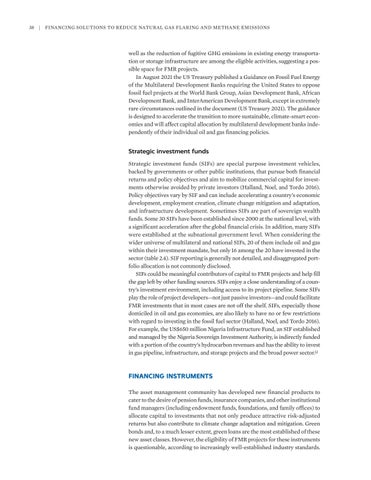38
| Financing Solutions to Reduce Natural Gas Flaring and Methane Emissions
well as the reduction of fugitive GHG emissions in existing energy transportation or storage infrastructure are among the eligible activities, suggesting a possible space for FMR projects. In August 2021 the US Treasury published a Guidance on Fossil Fuel Energy of the Multilateral Development Banks requiring the United States to oppose fossil fuel projects at the World Bank Group, Asian Development Bank, African Development Bank, and InterAmerican Development Bank, except in extremely rare circumstances outlined in the document (US Treasury 2021). The guidance is designed to accelerate the transition to more sustainable, climate-smart economies and will affect capital allocation by multilateral development banks independently of their individual oil and gas financing policies.
Strategic investment funds Strategic investment funds (SIFs) are special purpose investment vehicles, backed by governments or other public institutions, that pursue both financial returns and policy objectives and aim to mobilize commercial capital for investments otherwise avoided by private investors (Halland, Noel, and Tordo 2016). Policy objectives vary by SIF and can include accelerating a country’s economic development, employment creation, climate change mitigation and adaptation, and infrastructure development. Sometimes SIFs are part of sovereign wealth funds. Some 30 SIFs have been established since 2000 at the national level, with a significant acceleration after the global financial crisis. In addition, many SIFs were established at the subnational government level. When considering the wider universe of multilateral and national SIFs, 20 of them include oil and gas within their investment mandate, but only 16 among the 20 have invested in the sector (table 2.4). SIF reporting is generally not detailed, and disaggregated portfolio allocation is not commonly disclosed. SIFs could be meaningful contributors of capital to FMR projects and help fill the gap left by other funding sources. SIFs enjoy a close understanding of a country’s investment environment, including access to its project pipeline. Some SIFs play the role of project developers—not just passive investors—and could facilitate FMR investments that in most cases are not off the shelf. SIFs, especially those domiciled in oil and gas economies, are also likely to have no or few restrictions with regard to investing in the fossil fuel sector (Halland, Noel, and Tordo 2016). For example, the US$650 million Nigeria Infrastructure Fund, an SIF established and managed by the Nigeria Sovereign Investment Authority, is indirectly funded with a portion of the country’s hydrocarbon revenues and has the ability to invest in gas pipeline, infrastructure, and storage projects and the broad power sector.13
FINANCING INSTRUMENTS The asset management community has developed new financial products to cater to the desire of pension funds, insurance companies, and other institutional fund managers (including endowment funds, foundations, and family offices) to allocate capital to investments that not only produce attractive risk-adjusted returns but also contribute to climate change adaptation and mitigation. Green bonds and, to a much lesser extent, green loans are the most established of these new asset classes. However, the eligibility of FMR projects for these instruments is questionable, according to increasingly well-established industry standards.


